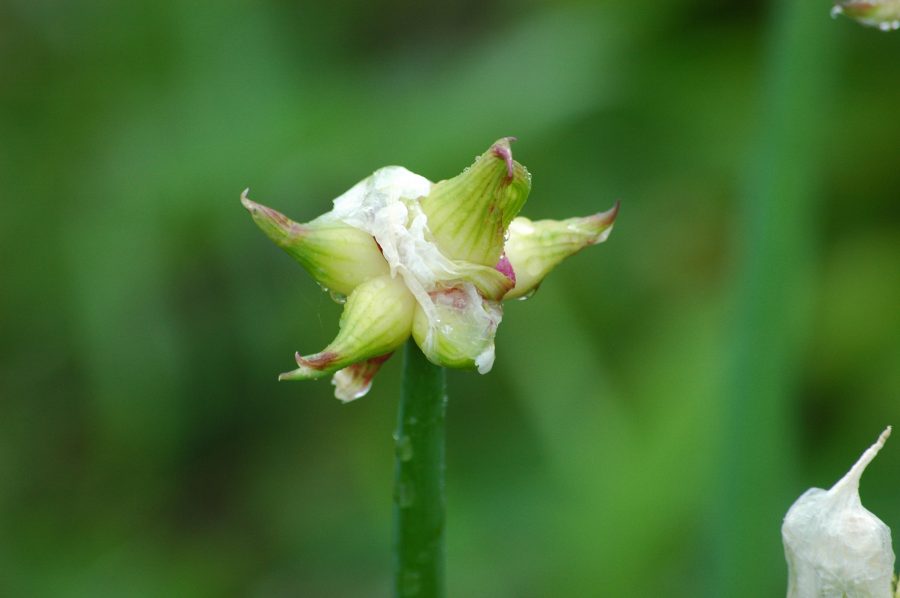Garlic How To Plant
This post may contain affiliate links. For more information, see my full disclosures here.
I love onions. Almost as much as I love mushrooms, but I haven’t tried growing mushrooms yet. That will be my next venture. Luckily my husband loves onions as much as I do so neither of us has to worry too much about onion breath.
A few weeks ago I spent a Saturday planting onion seeds. I spent yesterday putting those transplants into the garden. I must preface this by saying that I’m not talking about your typical white or yellow onion. I like those too, but they are easily purchased at a farmer’s market or local store and will keep in a dark pantry for weeks. What I am talking about are the other gems in the onion family: garlic, shallots, scallions, and leeks. They are easy to plant, easy to grow, and they taste divine.
Garlic (and Shallots*)
Garlic is bought in the grocery store in bulb form. You break sections off of the bulb which are called cloves. After peeling the skin, this is what you would use for cooking. Peel on, you can also use a clove for planting. If you’ve ever left a clove of garlic too long in the pantry it will grow a green sprout. In the ground that sprout would eventually turn into a plant, and that single clove would multiply into a whole bulb. So one garlic bulb can yield 8-10 or more cloves which in turn could give you 8-10 or more bulbs.
You can purchase garlic bulbs (seed garlic) through garden centers, seed catalogs, or online. Garlic you purchase in the store can be used, but I don’t recommend that you do. Store garlic, and other vegetables like potatoes, are sprayed with a growth retardant that keeps the vegetable from sprouting so that it will last longer. This can affect in ground growing. If you must use garlic purchased from a store, use organic.
Garlic is best planted in the fall in the North East. As long as the ground is workable, you can plant garlic. Find a permanent place in your garden in full sun as you won’t harvest your bulbs until the following summer or fall. Separate your bulbs into cloves and using only the largest cloves, plant in rows 4 inches apart root side down and pointy side up, approximately 2-4 inches deep. Once planted you should water and cover with a good 4-6 inch layer of mulch or leaves to keep the bulbs from heaving through the ground in the winter.
You may see growth in the fall, at the very least you’ll see growth in the spring. Remove the mulch/leaves in the spring and water during dry spells. Garlic will grow quickly through the spring and a tall curly stalk will shoot up with a bulb on the end. These are called garlic scapes. Once the stem curls around a few times, you’ll want to snap the stem off. If you don’t, the plant will go to seed and compromise your garlic bulb. Garlic scapes have a light garlic flavor and can be chopped and used much like scallions, which we will discuss below.
In late summer the leaves of your garlic plant will start to die back. Once they do, you can harvest your garlic bulbs. It is best to do this on a dry day. Dig the bulbs out of the ground, brush off the dirt, and then lay them on newspaper or cardboard to dry out. You’ll then need to hang your garlic indoors in a cool, dry, and dark place for a couple of weeks to cure. If stored in a cool, dry, and dark place (not the refrigerator) garlic will keep for several months.
*Shallots are very similar to garlic and can be planted the same way.
Scallions and Leeks
Scallions, also known as green onions, are used in Asian cooking and are the tall, slender, green stems with roots. You will see them sold in bunches in the produce section. Leeks are similar but are much larger.
Scallions and leeks can be grown from seed or what are called sets-which are small plants. They are very easily grown from seed. The first year I grew scallions and leeks I mad the mistake of placing a single seed in each little seed starting pot. DO NOT make the same mistake I did. Scallions and leeks will grow tiny seedlings that look like grass. Sprinkle the seeds in a large flat of soil. The seedlings can later be easily pulled out for transplanting.
You’ll want to plant seeds 8 weeks or more before your last frost. Scallions and leeks are slow to start and slow to grow. The seedlings can be placed in the garden 2-3 inches apart in early spring. Once in the garden, leave them be. Water during dry spells. You’ll barely be able to see the seedlings in the garden and will more than likely forget about them. Come late summer and fall you’ll be astonished that a tiny blade of green grew into a full stalk.
Scallions and leeks like cold weather and will keep in the garden long into fall. Only pull from the garden what you need. If you let a scallion plant set a flower and go to seed, you may be surpsised with new scallions the following spring.
There are so many different plants in the onion family and so many versatile uses for them. An added bonus is that they tend to keep pests at bay. Deer, rabbit, and woodchucks rarely touch them. Get the kids involved. When I dragged my six year old to our onion plot and pointed to the various plants his response was “boring”. When my husband told him that garlic keeps vampires away he said, “really?”
Reserve a spot in your garden this year and you’ll be rewarded come fall.
Do you have a favorite plant in the onion family or a favorite recipe? Let us know if the comments section or in our forums.



Thanks Ellen for stopping by! Leeks really are wonderful and can be cooked in a number of ways. They truly are easy to grow. Let me know if you try.
I adore leeks. As a Migraineur I need to try and stay away from Onions in favor of shallots, leeks etc, as they aren’t as likely to trigger a Migraine attack. It never occurred to me to try to grow leeks tho! This was an enjoyable post – thanks!!
Ellen